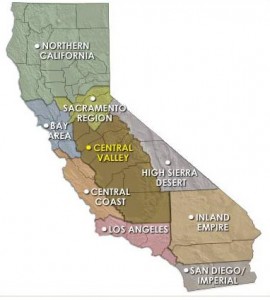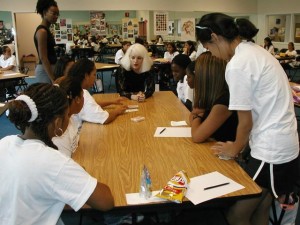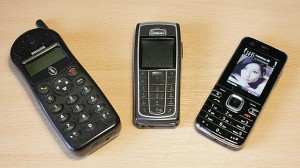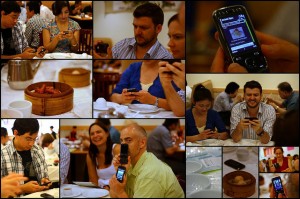Americans love lists and rankings — the Top 10 this, the Hottest that, the Best and Worst something else — and many magazines and Web sites get their highest readership when they publish a list.
CNNMoney.com, for instance, recently dug through U.S. Census data and compiled a list of the 10 metro areas with the highest percentage of college graduates. “Call it America’s brainiest places to live,” as the site put it.

A lot of smart people live in Georgetown — Washington, D.C.’s, most prestigious neighborhood. (Carol M. Highsmith)
In first place – Washington, D.C. Not too surprisingly, since it is also the nation’s wealthiest metro area and attracts lots of smart people seeking federal and defense-contractor jobs. Almost half of us who live in the Washington area (47.3%) have college degrees. Other communities in the Top 10 include San Jose, California, (hub of the Silicon Valley tech corridor) 3rd; Boston, Massachusetts, (more than 60 universities in the area) 5th; and New York, 10th (a surprise to me that it ranks so low, considering its financial and corporate clout.)
If the Top 10 are the brainiest, what does that make the Bottom 10? “America’s brain-deadest cities”? I noted that my hometown of Cleveland, Ohio, where just 25.9 percent of folks have college degrees, finished 10th from last. Another struggling industrial town, Detroit, Michigan, was 8th-lowest.

Housing developments have replaced most orange groves in Riverside, whose greater metropolitan area spreads all the way north into the San Bernardino Mountains to the north, and east across the desert to the Nevada border. (Wikipedia Commons)
I never would have guessed which metro area finished dead last. It is Riverside, California — which you may not have heard of. In this sprawling “exurb” of Los Angeles where the California fruit industry was born on the edge of the parched desert — just 19.2 percent of its folks have college degrees.
I wasn’t kidding about the “sprawling” part. What the Census Bureau lumps into “Riverside” is really California’s entire “Inland Empire,” which includes parts of two huge counties and 12 percent of the state’s entire population. These are blue-collar communities, heavy into agriculture, manufacturing, and construction. The last time we were there, we could hardly see the shopping centers, palm trees, and tracts of tile-roofed homes for all the dust kicked up by road graders, bulldozers, and the hot desert wind.

Check out the expanse covered by the Inland Empire, bottom right on the California map. (State of California)
Unfortunately, the Inland Empire is also the community with, by far, the nation’s highest unemployment: 15 percent. About 1 in 100 homes in the area is in foreclosure, as well.
Some 57 percent of the population is Hispanic. Many families cannot afford to send their children to college or prefer to keep them close to home. Many area young people who do go to college never come back, knowing that white-collar, professional job opportunities are few and far between.

In addition to her outreach efforts, Pamela Clute is a creative mathematician. Each summer on campus, she teaches math concepts to middle-school girls, who traditionally don’t get too excited about math. (University of California, Riverside)
“Many families don’t necessarily see the direct relevance between education and the economy,” says Pamela Clute, a vice provost at the University of California, Riverside. She is working with local high-school teachers and counselors as part of an area-wide effort to raise teacher expectations as well as students’ third-grade reading scores, seventh-grade algebra scores, and 12th-grade math scores. The overall goal is to encourage bright kids to keep at it, pursue scholarships if they cannot afford college tuition, and come back to the Riverside-San Bernardino area and build an intellectual environment that will encourage others to stay in school.
****
What Does ‘Dial’ the Phone Mean?
I call Carol on her cellphone 50 to 100 times a week. But I have no idea what the phone number is.

Some people refer to their cellphones as their “offices.” Others, as “my life in my hand.” Lose that phone, and, well . . . (hockeyshooter, Flickr Creative Commons)
That’s because, like many other people, I set up my cell and office phones by entering her number as one of the “frequently called” buttons, then labeling the entry “Carol.” Ever since: I push “Carol.” Phone rings. Carol sometimes answers. I have no idea what number I’m calling.
And it would seem that without these “shortcut” buttons, young people, in particular, couldn’t make a call if their lives depended on it.
I caught this headline on Amy Dickinson’s nationally syndicated “Ask Amy” advice column: “Kids need the 411 on land-line phones.” 411 is the local number Americans call to get help finding telephone numbers.
A school secretary wrote Amy to report what she called “an alarming trend.”

Kids want to know what’s going on. Not in general. This very second. (bobster 855, Flickr Creative Commons)
Students are not permitted to use cellphones at her school, but they may use the office phone to call home. Problem is, the secretary reported, the students don’t know their home numbers, or their parents’ cellphone numbers — even the numbers of their BFFs (best friends forever). They’ve always just punched a button or touched a spot on their “smart phone” screens. Even if the number appears there, they pay no attention to it. Good luck should they ever lose their mobile phones. They’d have what my mother used to call a “dickens of a time” reaching someone using any other phone.

A lot of young people view as some sort of unfathomable historical relic. Even the word “telephone” is antiquated. They’re just “phones” now, and they fit in the palm of your hand. (Library of Congress)
What also amazed the school secretary was that many students, confronted with the office desk telephone, treated it like a cellphone. They punched in the number with the receiver still sitting in its cradle, then picked up the receiver and were dumbfounded* why the call wasn’t going through. *Note that the root word in “dumbfounded” is “dumb.”
++++++ We interrupt this inspection of clueless young people with this update, courtesy of the Wall Street Journal. It seems that the typical American teenager texts someone an average 3,339 times each month. That’s 111 per day in a 30-day month. Figuring that this thumb-weary generation to which we are entrusting our future sleeps or is otherwise engaged 13 hours a day, that means they’re texting 10 times each cognizant hour. As the Journal concluded, “U Love Texts.” Kids prefer to communicate in microbursts as opposed to saying anything complicated. They are frenzied to send the very, very latest trivial tidbit — “Joey likes Mindy. Yeah, really!” Or “JLVM YARLY,” in text talk.
With such breathless updates to attend to, it’s no wonder teens don’t know how to dial a telephone. Imagine their confusion if someone handed them a rotary phone. A W@*? (Text talk for “A what?”) ++++++
If you ask me — you didn’t, I know — this somehow relates to today’s information overload. We can’t even find the time to memorize one or two critical phone numbers. Gadgets handle everything. It’s part of the dumbing-down revolution.
A grumpy overstatement? Consider more examples:
• We all write emails, to the point that the U.S. Postal Service is on the brink of collapse for a lack of real letters to deliver. And we email “regulars” frequently. When I begin to type “Carol Highsmith,” for instance, I get no farther than the “C” before the computer fills in the rest of her name and adds her email address. That’s a fabulous time-saver, but when I use another computer that doesn’t know “my” Carol from Carol Burnett or a Christmas carol, I have to keep on typing. No problem with the name. But in computer talk, is she carolhighsmith? carolhigh? carolhi? chigh? And who’s her email provider again? Adults can be clueless, too.

“You want me to do WHAT? Get up and change the channel? What are you, crazy?” (alvi2047, Flickr Creative Commons)
• These days, we navigate on our television sets via remote control instruments. We impatiently flick among hundreds of channels, play movies, record shows, zip through commercials — not to mention turning the set on and off. Misplace the little box, and we’re toast. Just finding the “on” button on the set itself is a feat. And when’s the last time any of us stood next to the console, changing channels one at a time? 1987? Two of my favorites are cable channels 50 and 181. How many times do you think we schlumps would get up from our chairs and trudge over to the television set, just to press “up” or “down” on the channel selector 131 times?
Yup, there are five essentials to modern life: air, water, food, love, and the TV remote control.
• Then there’s the matter of “apps,” or applications. They have made smart phones and electronic “tablets” like the iPad so indispensable that experts are starting to use the words “laptop computer” and “obsolete” in the same sentence.

You want apps? How many days do you have to look through all the possibilities? (mjdave, Flickr Creative Commons)
More than 250,000 apps have been created so far. All are cheap, and many are free. You name it; there’s an app for it. I wouldn’t be shocked if you told me you found an app that will make your bed or pop your popcorn. Here are just a few real examples:
• MyNature Animal Tracks. Spot some animal prints? This app will identify the critter that left them.
• Mercedes-Benz mbrace. Locks, unlocks, and — most important — finds your Mercedes, should you be lucky enough to own one.
• Closest House for Sale. Self-explanatory.
• Allure Mobile. Controls home heating and air-conditioning from a mobile phone, even if you’re 1,000 km from home.
• Walky Talky. Uses global positioning satellite technology to guide the sighted-impaired from point to point.
• iFitness. Illustrates hundreds of exercises and helps you program your own workout.
• Trainyard. You “draw” tracks to guide trains of different colors to their color-coded stations. It’s easy until all the tracks start crossing.
• Scoops. An ice-cream app! You pile scoops of ice cream atop a cone by tilting your phone while somehow avoiding vegetables, of all things.
• Rocket Taxi. Finds nearby cab companies and calls you a cab — “you’re a cab?” — with a tap of your finger.
• And what could be most useful of all: a “universal decision maker” that replaces coin flips.
Geeks who write tekky columns are light years ahead of me in understanding and explaining how all these mini-wonders appeared and how they work. This interlude has been for the rest of us.
****
Say What?
As you can imagine, bloggers get a lot of odd comments. I got one, for instance, that consisted of a single sentence: “Ever had a hamster caught in the ductwork?” with no further explanation. Had I ever written about either hamsters or ductwork, I’d have gladly published this and replied.
Hmm. Looks like I just did write about hamsters and ductwork.
****
Dept. of Shameless Plugs
 I mention Carol quite often, and you see and hopefully appreciate her photographs embedded within my posts and zipping along in a slide show in the column to the right. She is embarking on quite a lifetime project which the Washington Post wrote about recently. Check it out at the link.
I mention Carol quite often, and you see and hopefully appreciate her photographs embedded within my posts and zipping along in a slide show in the column to the right. She is embarking on quite a lifetime project which the Washington Post wrote about recently. Check it out at the link.
Ted's Wild Words
These are a few words from this posting that you may not know. Each time, I'll tell you a little about them and also place them into a cumulative archive of "Ted's Wild Words" in the right-hand column of the home page. Just click on it there, and if there's another word that you'd like me to explain, just ask!
Feat. A notable accomplishment or exploit, often a physical one.
Schlump. A lazy, lethargic person. Schlumps are also often schlubs! (clumsy and slovenly folks) as well. Both words migrated from the Yiddish language.



2 responses to “Smart Towns, Clueless Kids”
I fairly randomly happened upon your “Smart Towns, Clueless Kids” posting and wanted to make a few comments that may or may not have occurred to you already but are worth thinking about. It does seem like people are missing out on potentially important information when they do not know the actual phone numbers of their friends and family but, quite frankly, they are unnecessary and will probably never be necessary again.
Let me illustrate what I mean through example. I left my cell phone on while flying across the country in a plane by accident. This doesn’t actually cause disruption to the plane’s instruments but what it does do is kill the entire battery of the phone as it desperately searches for service while zipping from one tower to another (it can also overwhelm the towers but that is for another day).
The result was a dead phone when I landed. I then realized I didn’t actually know what my girlfriend’s number was and she was supposed to come pick me up. So, what did I do? I borrowed the phone next to me, went online, signed into facebook, looked her up, clicked her cell number in her profile which dialed automatically, told her my cell was dead and where I’d meet her, and wrote the number down just in case. Similarly, if any young person loses their phone they just post on a social network and everyone sends them their numbers. In reality, this system is obsolete already as well as Verizon (and I’m sure others) already automatically back-up all your contacts to their servers for this very reason for instant retrieval.
The lack of these seemingly basic pieces of information doesn’t make a person dumber, considering young people could tell you more about the above apps than you could tell them about cell phones, I’d say they have simply swapped out the relatively useless for the modern and pertinent.
Now, it is true you’d be out of luck if you knew nobody’s number at all and had no phone but this is pretty unlikely and isn’t much different than when a small child was lost back in the times before cell phones. The best bet would be to simply go online and send an email which will be saved in contacts and likely received instantly on a phone. Finding a computer or smartphone with internet is no harder than finding a payphone ever was.
Lastly, when you mention rotary phones and imagine how young kids would be dumbfounded as to how they work, imagine how they see you, every day, struggling with smartphones, computers, and technology in general. Then ask yourself, which person looks dumb in today’s world? The one scratching their head in front of a device that hasn’t been used in their lifetime and never will be again or the one who can’t operate a basic device used by millions, including 10 year olds, with ease?
Sorry for the extremely long comment but I thought you might find this perspective interesting if it isn’t one you commonly look from. As a current law student I can only smile knowingly when I have to learn how to look up cases in actual books knowing this technique is pretty much already obsolete, “just in case.” I remember learning how to use the card catalogs when I was in kindergarten for the same reason and I also remember unloading them at the dump when I worked a summer job for the school system in college. Ah, technology! It never stops.
I love Virginia! Anyhow… I really love reading your blog for the reason that you usually post well written pieces of information about my favorite topics. Very nice blog post… I enjoyed it once again. I have already bookmark this website. I think I will subscribe to your feed as well!